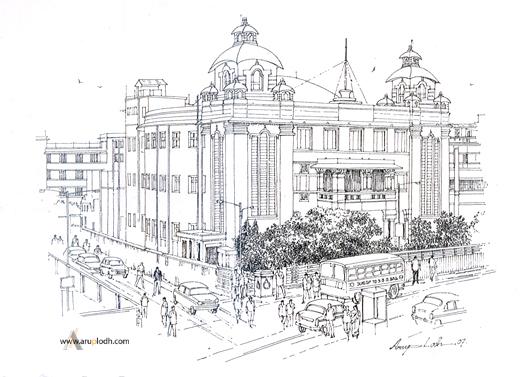🤝When great minds joined forces, a remarkable initiative unfolded.🤝🧵
In May 1937, Subhash Chandra Bose organized a meeting at his residence on Elgin Road, where distinguished youth of Calcutta were in attendance.
In May 1937, Subhash Chandra Bose organized a meeting at his residence on Elgin Road, where distinguished youth of Calcutta were in attendance.

Among the organizers was Bose's close friend, advocate Nripen Mitra. During the meeting, Bose addressed the need for a proper multipurpose gallery in the city to host special events. 

A few days later, Netaji finalized the acquisition of a 38 katha land between Central Avenue and Harison Road, as advised by the Kolkata Municipal Corporation. The corporation leased the land to Bose for the nominal amount of one rupee as a gesture of support. 

Bose approached Rabindranath Tagore, requesting his creative guidance and assistance in various aspects of the project, from naming to planning. 

In response, Tagore named the auditorium Mahajati Sadan and entrusted the responsibility of planning to veteran architect Surendranath Kar from Shanitekan. Kar meticulously designed and executed Mahajati Sadan, incorporating Tagore's vision and Bose's inputs. 

On August 19, 1939, the foundation stone of Mahajati Sadan was laid in a grand ceremony attended by Rabindranath Tagore, Bose, Dr. Bidhan Ch. Roy, & many other notable figures from Kolkata. Tagore delivered a captivating speech during the event, setting the tone for the project. 

However, in 1941, Bose left the country which led to the British government declaring him a convict, resulting in the suspension of the project registered under his name. The lease was confiscated, bringing the project to a standstill. 

Nevertheless, Sarat Chandra Bose & Nripen Mitra made tremendous efforts to revive and reinstate the project. After a prolonged legal battle and numerous court cases, the verdict was finally declared in their favour. The English government's decision was made illegal and invalid. 

Unfortunately, significant turmoil ensued, making it challenging to resume the project. The country achieved independence in 1947, and the project regained momentum in 1948. 

That year, the Mahajati Sadan bill was passed in the state assembly, officially taking the project under the government of West Bengal's jurisdiction. Construction recommenced following the original plan and was ultimately completed in 1958. 

On August 19, 1958, Mahajati Sadan was inaugurated by the then Chief Minister, Dr. Bidhan Chandra Roy, who had also been present at the foundation stone-laying ceremony. During the inauguration, Dr. Roy paid tribute to the two luminaries associated with the project. 

The present address of Mahajati Sadan is 166, Chittaranjan Avenue, Kolkata 007. The entrance consists of bust figures of Bose and Tagore on either side. It has a heritage auditorium inside with over 1000 seats, multiple galleries, 

and a 100-seater heritage conference room. There are many rare photographs from Kolkata's history displayed inside, along with valuable paintings and portraits of luminaries. 

There is a separate and permanent exhibition based on the history of the freedom movement in India and the life of Netaji inside the Sadan. However, one of the most enriching assets of Sadan is its huge library full of valuable and extremely rare resources. 

After B.C Roy's death, his entire personal book collection has become a part of this library, which has been named after him. Not only B.C Roy, but the personal collections of many eminent individuals of the city have been preserved here. 

Initiated and envisioned by Netaji Subhash Bose, nurtured by Rabindranath Tagore, and finally given its final form by Bidhan Chandra Roy, Mahajati Sadan is the brainchild of three geniuses and is the rarest example of such dream collaboration. 

It has witnessed some of the greatest events in the country and continues to carry on its legacy to this day. Extraordinary auditoriums with modern facilities will come up in the city, but the legacy and heritage of Mahajati Sadan will live on forever.
END
END

• • •
Missing some Tweet in this thread? You can try to
force a refresh























